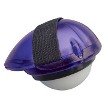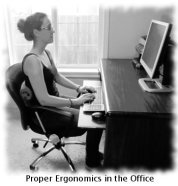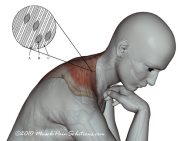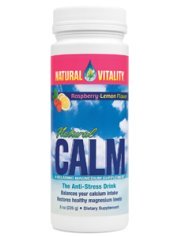The Best Trigger Point Tools
In my quest to find ever better ways for patients to treat themselves, I have tried many trigger point tools and would like to share my thoughts on them. This page reviews some of the tools available, to let you know the up and downsides of each. Ideally, I would recommend a combination of a hand tool and a larger curved tool to be able to work all areas effectively.
Theracane and Back Buddy

One of my favorite trigger point tools is the Theracane. It is very versatile and can be used on almost any area of the body. I recommend this tool to any of my patients that have ongoing pain. It costs less than a massage but lasts a whole lot longer! The hook allows you to treat trigger points on your backside, and the handles leverage sufficient pressure to perform deep stroking massage or the lighter trigger point pressure release technique.
You can also hook the Theracane under your leg in a seated position and massage your arm. I like to use the two "handles" to work the outside of both legs to get both IT bands (Illiotibial bands) at the same time. It is also effective for working muscles in the abdomen such as the illiopsoas muscle. The two smaller knobs on the cane can be used at the base of the skull and on areas that need a smaller knob like the hands and arms. However, I don't find it to be as effective for the hands and arms as for the rest of the body. For those areas, I recommend using one of the smaller tools, such as the Knobble. The Theracane comes with a small pamphlet about trigger point work that shows a variety of ways to use this device that you might not think of.
The Body Back Buddy is very similar to the Theracane with the advantage of having additional knobs and another hook. However, this tool is also a little bulkier, and I personally prefer the texture of the Theracane (smoother), but it is still s great tool.
There is a smaller version, the Body Back Buddy Jr. which looks to be as versatile and slightly less bulky. It is also less expensive, but the complaint here is that the curve is too small to reach the backs of larger people. There are many other trigger point tools with this basic shape, many of which seem as though they would work just fine.
Pros for Large Curved Trigger Point Tools
- reach anywhere, i.e. back, abdomen, legs
- good leverage due to extra "handles"
- multiple sized knobs
Cons
- large — hard to pack
- not as good for hands and arms
Similar Trigger Point Tools
S-Curve Models —There are several models, such as

The Original Back Knobber that are in the shape of a smooth S-curve. I don't recommend purchasing these because it is harder to get enough leverage on them. You want something with handles that you can pull on to generate enough force to work on the trigger points without exhausting yourself. However, if you already have an S-curve, by all means use it!
There is another larger product called The Pressure Pointer. It is quite large, giving the advantage of being able to use your legs to generate the leverage to work on upper back, but it creates a storage problem, and the complexity of using it will probably deter one from using it 3-6 times per day as is ideally recommended. It is also almost double the cost of other tools.
Small Hand Held Trigger Point Tools

The Knobble is a great tool for working the "reachable" areas on your body while saving your hands. I highly recommend using a tool if you plan on doing much trigger point work because applying this pressure wears out your hands. This tool is nice because it sits in the palm of your hand and you can use your whole hand to apply the pressure. The knob is a good size for trigger point work, and the device is small enough to carry with you in your purse or coat pocket.

The Original Jacknobber is nice because it has multiple size knobs to use and you can rub two or three areas at once. One advantage of this over the Knobble is that you can position this against a chair or wall and use it on your back. The drawbacks are, that it is not as compact, and it is a little more awkward to hang on to. This awkwardness is reduced in The Original Palmassager.
Pros for hand held trigger point tools
- small and portable
- great for all "reachable" areas, especially hands and arms
- save your hands from strain/injury
Cons
- cannot use for "un-reachable" areas

Rolling massage tools are not specific enough for trigger point work. Trigger points are small and deep. While the Porcupine Massage Balls may feel good and relaxing, they are also not a good choice for trigger point work. The same goes for the various vibrating massage tools on the market... great for relaxation but not to work out your trigger points.
Massage Sticks or Rollers
While these tools are not great at getting to individual trigger points, they do a good job of working on a large body of muscles at the same time. I think they are a good idea for runners, people that exercise their legs vigorously, or people with consistent leg pain. It would be useful for general tension and for preventing trigger point formation. Some of the longer ones can be used in a general way over the whole back. I think the ones that have a firm foam over the roller are a little better since they won't bruise bony parts (e.g. vertebrae) as they roll over them. The Tiger Tail Rolling Muscle Massager has the firm foam on it. If you like to "do-it-yourself", you can make one by buying PVC pipes, one smaller than the other, and put foam around the outside of the larger diameter pipe and handles attached to the inside one, or just let it stick out beyond the larger diameter pipe, and you will have a rolling massager.
You can also purchase a High Density 6" Foam Roller to work the outsides, front and backs of your legs as well as your back. You can lean against it on the wall or lie on it and roll it over the areas that hurt. Either roll to a part that hurts and wait till the pain goes away, or slowly roll back and forth over the painful areas. This is nice for areas that are hard to get enough pressure on like the side of your hips. For you back, it works the best to lie on it parallel to your spine, and roll sideways on it. Foam rollers are inexpensive and versatile, as you can use them for balance exercises as well as massage, and even to stretch out your back. Start with light pressure against a wall and work up as it becomes more comfortable, as you can bruise yourself if you are not careful.
Pros for Rolling Trigger Point Massage Tools
- treat larger areas at a time
- good for post exercise muscle work
Cons
- does not apply specific pressure to trigger points
- somewhat bulky
Do-it-yourself Trigger Point Massage Tools
Hand tools
Hot rocks can make great trigger point tools. Try to find smooth basalt (black) rocks in interesting shapes. (A great reason for a trip to the Oregon Coast! or…local nursery if you are land bound.) Or you can purchase professional massage stones. Put them in water on the stove top on low and heat the water to very warm, where you are still able to reach into the water (about 120°F). Test the rock temperature on the back of your hand to make sure they are not going to burn your skin. When they are very warm but not burning, use them on your skin for a very comforting effect. You can oil the rocks and/or use lotion on the skin to decrease the friction. You can also set up warm water in a crock pot with a bunch of rocks so you can switch them out as they get cool. To use, first lay them over the trigger points to relax the muscles for a minute or two, then apply pressure as you would with any other massage tool.
Bouncy balls, lacrosse balls, and baseballs work well to apply pressure to many trigger points. Tennis balls can work in a pinch, but tend to be a little too soft for deeper trigger points. Pencil Erasers work well for small areas like on the back of your hand. I have even used the blunt end of a Sharpy Marker in a pinch.
Tools to reach your back
One of the easiest-to-make trigger point tools is a tennis ball in a long sock. As stated before, a lacrosse or bouncy ball is better, but the tennis ball will do. You can hang it behind your back, and then lean on a wall to get the leverage you need. You can also put the ball on the floor and roll around on it. Of course, it is not as easy to use as one the tools made for this job, but it is more portable and almost free! You can also put the smaller massage tools listed above in a sock to use them on your back. You can put two tennis balls in a sock and put it at the base of your skull to work muscles there more easily on both sides.
A regular cane can be used to reach your back. There are usually door and cabinet knobs available to lean into. You can use a baseball bat almost like a foam roller (though you might need to use it over a softer surface). I sometimes put my fist against the wall with my knuckles facing my body and lean into that... that is something you always have on hand =)
Be creative! I am sure you will find something smooth and hard that you can use to get rid of those pesky trigger points!
Pros to Free Trigger Point Massage Tools
- Free!
- readily available
Cons
- harder to get the specific angle needed for inaccessible areas
In summary, your best bet is a combo of a longer tool like the theracane and a small tool like the knobble. Hopefully, this review has helped you understand the various tools available and which ones might be the most helpful for you in particular. Happy trigger point hunting!!!
For information on how to use these tools, visit Trigger Point Massage Therapy.
Return from Trigger Point Tools to Trigger Point Treatment.
Return from Trigger Point Tools to Muscle Pain Solutions Home Page.







